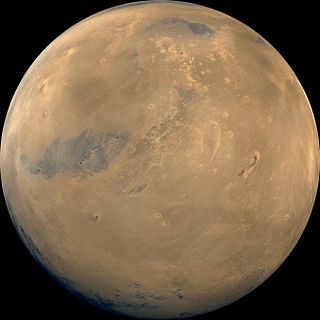 W
WAngustus Labyrinthus is a complex of intersecting valleys or ridges near the Martian south pole, located at 81.68° S and 63.25° W. It was nicknamed the "Inca City" by NASA scientists due to its superficial resemblance to a ruined city. Like other formations in the area, the name 'Angustus' derives from a name given by Eugene Antoniadi in 1930 to an albedo feature that corresponds with the area. The name was approved in 2006.
 W
WAurorae Sinus is a dark feature in the southern hemisphere of the planet Mars. Together with albedo features contributed by Aonius Sinus and Solis Lacus, it is part of a feature known as the "eye of Mars".
 W
WCerberus is a large "dark spot" located on Mars and named after the mythical dog Cerberus. The arcuate (curved) markings in the upper right are in the Amazonis plains and may be sand drifts. The volcano Elysium Mons, a yellow area north of Cerberus, has several channels radiating from its flanks. The three bright spots, upper left, are volcanoes partially veiled by thin clouds.
 W
WCydonia is a region on the planet Mars that has attracted both scientific and popular interest. The name originally referred to the albedo feature that was visible from Earthbound telescopes. The area borders the plains of Acidalia Planitia and the Arabia Terra highlands. The area includes the regions: "Cydonia Mensae", an area of flat-topped mesa-like features, "Cydonia Colles", a region of small hills or knobs, and "Cydonia Labyrinthus", a complex of intersecting valleys. As with other albedo features on Mars, the name Cydonia was drawn from classical antiquity, in this case from Cydonia or Kydonia, a historic polis on the island of Crete. Cydonia contains the "Face on Mars", located about halfway between Arandas Crater and Bamberg Crater.
 W
WMare Erythraeum is a very large dark dusky region of Mars that can be viewed by even a small telescope. The name comes from the Latin for the Erythraean Sea, because it was originally thought to be a large sea of liquid water. It was included in Percival Lowell's 1895 map of Mars.
 W
WMeridiani Planum is a plain located 2 degrees south of Mars's equator, in the westernmost portion of Terra Meridiani. It hosts a rare occurrence of gray crystalline hematite. On Earth, hematite is often formed in hot springs or in standing pools of water; therefore, many scientists believe that the hematite at Meridiani Planum may be indicative of ancient hot springs or that the environment contained liquid water. The hematite is part of a layered sedimentary rock formation about 200 to 800 meters thick. Other features of Meridiani Planum include volcanic basalt and impact craters.
 W
WPhlegra Dorsa is a region in the Amazonis quadrangle of Mars located at 25.08 N and 170.37 E. It is 2818.61 km across and was named for classical albedo feature. The classic feature meant "burning plain; it was a place in Chalcidian Peninsula of Greece where Zeus hurled thunderbolts at Titans to support Hercules. The name Phlegra Dorsa was approved in 2003.
 W
WSinus Meridiani is an albedo feature on Mars stretching east-west just south of that planet's equator. It was named by the French astronomer Camille Flammarion in the late 1870s.
 W
WSolis Lacus is a dark feature on Mars. It was once called "Oculus" and is still commonly called "The Eye of Mars" because with the surrounding light area called Thaumasia it resembles the pupil of one. Solis Lacus is known for the variability of its appearance, changing its size and shape when dust storms occur.
 W
WSyrtis Major Planum is a "dark spot" located in the boundary between the northern lowlands and southern highlands of Mars just west of the impact basin Isidis in the Syrtis Major quadrangle. It was discovered, on the basis of data from Mars Global Surveyor, to be a low-relief shield volcano, but was formerly believed to be a plain, and was then known as Syrtis Major Planitia. The dark color comes from the basaltic volcanic rock of the region and the relative lack of dust.
 W
WUtopia Planitia is a large plain within Utopia, the largest recognized impact basin on Mars and in the Solar System with an estimated diameter of 3300 km. It is the Martian region where the Viking 2 lander touched down and began exploring on September 3, 1976, and it is the target of the 2020 Tianwen-1 rover and lander mission. It is located at the antipode of Argyre Planitia, centered at 46.7°N 117.5°E. It is also in the Casius quadrangle, Amenthes quadrangle, and the Cebrenia quadrangle of Mars.